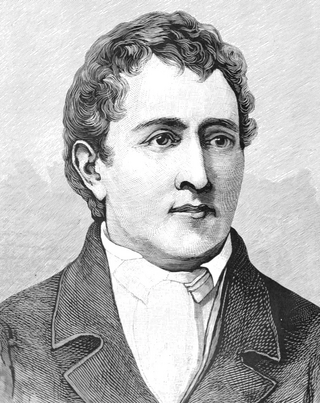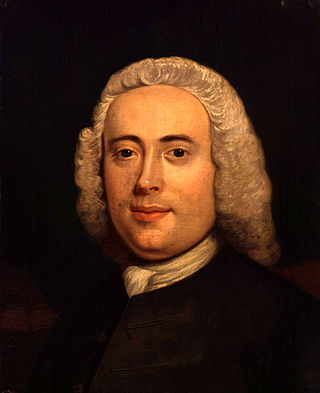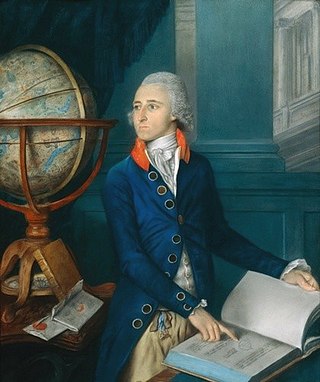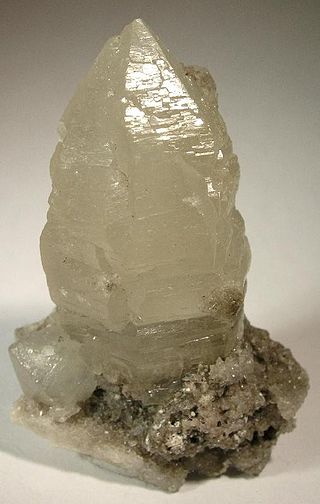Related Research Articles

1784 (MDCCLXXXIV) was a leap year starting on Thursday of the Gregorian calendar and a leap year starting on Monday of the Julian calendar, the 1784th year of the Common Era (CE) and Anno Domini (AD) designations, the 784th year of the 2nd millennium, the 84th year of the 18th century, and the 5th year of the 1780s decade. As of the start of 1784, the Gregorian calendar was 11 days ahead of the Julian calendar, which remained in localized use until 1923.

Carl Wilhelm Scheele was a Swedish German pharmaceutical chemist.

Henry Cavendish was an English natural philosopher and scientist who was an important experimental and theoretical chemist and physicist. He is noted for his discovery of hydrogen, which he termed "inflammable air". He described the density of inflammable air, which formed water on combustion, in a 1766 paper, On Factitious Airs. Antoine Lavoisier later reproduced Cavendish's experiment and gave the element its name.
The year 1812 in science and technology involved some significant events, listed below.
The year 1781 in science and technology involved some significant events.
The year 1743 in science and technology involved some significant events.
The year 1800 in science and technology included many significant events.
The year 1783 in science and technology involved some significant events:
The year 1780 in science and technology involved some significant events.
The year 1774 in science and technology involved some significant events.

John Canton was a British physicist. He was born in Middle Street Stroud, Gloucestershire, to a weaver, John Canton and Esther. As a schoolboy, he became the first person to determine the latitude of Stroud, while making a sundial. The sundial caught the attention of many, including Dr Henry Miles, a Stroud-born Fellow of the Royal Society. Miles encouraged Canton to leave Gloucestershire to become a trainee teacher for Samuel Watkins, the headmaster of a Nonconformist school in Spital Square, London, with whom he ultimately entered into partnership.

John Goodricke FRS was an English amateur astronomer. He is best known for his observations of the variable star Algol in 1782.
Major-General William Roy was a Scottish military engineer, surveyor, and antiquarian. He was an innovator who applied new scientific discoveries and newly emerging technologies to the accurate geodetic mapping of Great Britain. His masterpiece is usually referred to as Roy's Map of Scotland.

Jesse Ramsden FRS FRSE was a British mathematician, astronomical and scientific instrument maker. His reputation was built on the engraving and design of dividing engines which allowed high accuracy measurements of angles and lengths in instruments. He produced instruments for astronomy that were especially well known for maritime use where they were needed for the measurement of latitudes and for his surveying instruments which were widely used for cartography and land survey both across the British Empire and outside. An achromatic eyepiece that he invented for telescopes and microscopes continues to be known as the Ramsden eyepiece.

Witherite is a barium carbonate mineral, BaCO3, in the aragonite group. Witherite crystallizes in the orthorhombic system and virtually always is twinned. The mineral is colorless, milky-white, grey, pale-yellow, green, to pale-brown. The specific gravity is 4.3, which is high for a translucent mineral. It fluoresces light blue under both long- and short-wave UV light, and is phosphorescent under short-wave UV light.

The Principal Triangulation of Britain was the first high-precision triangulation survey of the whole of Great Britain and Ireland, carried out between 1791 and 1853 under the auspices of the Board of Ordnance. The aim of the survey was to establish precise geographical coordinates of almost 300 significant landmarks which could be used as the fixed points of local topographic surveys from which maps could be drawn. In addition there was a purely scientific aim in providing precise data for geodetic calculations such as the determination of the length of meridian arcs and the figure of the Earth. Such a survey had been proposed by William Roy (1726–1790) on his completion of the Anglo-French Survey but it was only after his death that the Board of Ordnance initiated the trigonometric survey, motivated by military considerations in a time of a threatened French invasion. Most of the work was carried out under the direction of Isaac Dalby, William Mudge and Thomas Frederick Colby, but the final synthesis and report (1858) was the work of Alexander Ross Clarke. The survey stood the test of time for a century, until the Retriangulation of Great Britain between 1935 and 1962.

Sir Charles Brian Blagden FRS was an English physician and chemist. He served as a medical officer in the Army (1776–1780) and later held the position of Secretary of the Royal Society (1784–1797). Blagden won the Copley Medal in 1788 and was knighted in 1792.
Events from the year 1784 in Great Britain.
The Anglo-French Survey (1784–1790) was the geodetic survey to measure the relative position of the Royal Greenwich Observatory and the Paris Observatory via triangulation. The English operations, executed by William Roy, consisted of the measurements of bases at Hounslow Heath (1784) and Romney Marsh (1787), the measurements of the angles of the triangles (1787–1788) and finally the calculation of all the triangles (1788–1790). The survey is very significant as the first precise survey within Britain, and the forerunner of the work of the Ordnance Survey which was founded in 1791, one year after Roy's death.

Cosimo Alessandro Collini was an Italian historian and Voltaire's secretary from 1752 to 1756.
References
- ↑ Haüy, René Just (1784). Essai d'une théorie sur la structure des crystaux. Paris: Gogué.
- ↑ Scheele, Carl Wilhelm (1784). "Anmärkning om Citron-saft, samt sätt at crystallisera densamma" [Note about lemon juice, as well as ways to crystallize it]. Kungliga Vetenskaps Academiens Nya Handlingar [New Proceedings of the Royal Academy of Science]. 2nd series (in Swedish). 5: 105–109.
- ↑ Graham, Thomas (1842). Elements of chemistry, including the applications of the science in the arts. London: Hippolyte Baillière. p. 944 . Retrieved 2010-06-04.
- ↑ The College of Optometrists. "The 'Inventor' of Bifocals?". Archived from the original on 13 June 2011. Retrieved 2011-06-21.
- ↑ Collini, C. A. (1784). "Sur quelques Zoolithes du Cabinet d'Histoire naturelle de S.A.S.E. Palatine & de Bavière, à Mannheim". Acta Theodoro-Palatinae Mannheim 5 Pars Physica: 58–103.
- ↑ Taquet, P.; Padian, K. (2004). "The earliest known restoration of a pterosaur and the philosophical origins of Cuvier's Ossemens Fossiles". Comptes Rendus Palevol. 3 (2): 157–175. doi:10.1016/j.crpv.2004.02.002.
- ↑ Unwin, David M. (2006). The Pterosaurs: From Deep Time. New York: Pi Press. ISBN 0-13-146308-X.
- ↑ Cavendish, Henry (1784). "Experiments on Air" (PDF). Philosophical Transactions of the Royal Society of London . 75: 372–384. doi: 10.1098/rstl.1785.0023 . JSTOR 106582.
- ↑ Roy, William (1785). "An Account of the Measurement of a Base on Hounslow-Heath". Philosophical Transactions of the Royal Society of London. 75: 385–480. doi: 10.1098/rstl.1785.0024 .
- ↑ No. 1432.
- ↑ Gazette d'Amsterdam 25 June 1784; Journal des sçavans November 1784 pp. 760-762.
- ↑ Gales, W. K. V. (1981). Ironworking. Princes Risborough: Shire. p. 8. ISBN 0-85263-546-X.
- ↑ "Copley Medal | British scientific award". Encyclopedia Britannica. Retrieved 21 July 2020.